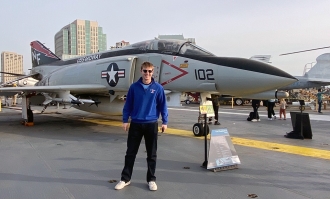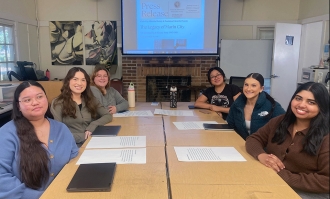- News
- News Archive
- History Students Partner With Call Of The Sea To Support Project
History Students Partner With Call Of The Sea To Support Project

Christina Pathoumthong ’22 attended high school in Lafayette, only 20 miles outside San Francisco. But, when it came to studying history, her high school curriculum focused primarily on World History rather than the many events that took place in California, specifically the Bay Area.
Despite growing up in Napa, it was not until she started studying history at Dominican that Aisleen Renteria ’21 became aware of the significant historical events that took place in her Northern California backyard.
None of this comes as a surprise to Dr. Jordan Lieser, assistant professor of history in the School of Liberal Arts and Education.
“The social science learning standards for junior high and high school barely touch on California history,” Lieser says. “In elementary school you learn some of the basics but, due to the lack of California history in the standards, it is really left to the teachers to include California history in their courses beyond things such as the Gold Rush.”
When Sausalito-based educational nonprofit Call of the Sea (COTS) approached Lieser about developing content to support COTS educational programs, he saw this as the perfect opportunity to involve his Public History students in a project that would provide junior high and high school teachers with resources focused on California history.
Last semester 20 Dominican students – assisted by six alumni – worked with COTS and local historians to develop a series of educational materials for 8th and 11th grade students, including grade-specific lesson plans that meet requirements found in the California State Learning Standards for History and Social Science.
The students also developed accompanying materials – oral history recordings, interactive maps, videos, and podcasts – along with hands-on activities that can take place on the Matthew Turner tall ship, which serves as the COTS floating classroom.
“Our partnership with Call of the Sea links the national narratives that students learn in the classroom to local, Bay Area history that our students researched themselves,” Lieser says. “We provided flexible and engaged learning lesson plans for 8th and 11th graders – a wealth of materials and support structures designed to assist teachers in their attempt to connect the history students learn in their textbooks to the history they can see in their own communities.”
APPLY NOW FOR FALL 2021
The content is divided into four modules: "Unrest and Protest," "Migration History," "Defending the Bay," and “Maritime History.” Each module offers a pre-lesson, a hands-on project designed to take place on the Matthew Turner, and additional lessons to take place after the Call of the Sea experience.
For Aisleen, who is majoring in political science with a minor in history and Latin American studies, Lieser’s course offered a refreshing approach to history.
“What I expected going into this course was learning about the history that has not been taught in most public and private institutions,” Aisleen says. “Often, we are educated on European history and are told the same narrative throughout our middle school and high school education — but to be taught the `forgotten’ history of the Bay Area was such a grand opportunity.”
Katya Palacios ’21, a political science major with minors in history and Latin American studies, knew right away that she wanted to focus on immigration, a subject that has interested her throughout her college career and one she hopes to pursue in law school.
“Throughout my entire college career, I took any opportunity to learn more about immigration history and write multiple research papers about similar topics,” she says. “I was born and raised in San Francisco and I love this city so much. Doing deep research on the impact and history of immigration in the Bay Area would inspire research topics for my senior capstone project.”
Katya researched the impact of the Bracero Program in the Bay Area, collecting and analyzing interviews and images from the 1940s and 50s. She had briefly studied the Braceros in high school.
“It was nice to revisit the subject,” she says. “After listening to the interviews, I learned about the stories of the Braceros that arrived in the Bay Area for work and who returned back home to Mexico. History is so vast and long that no matter which time period or subject one is researching, there is always something new to learn.”
The immigration group developed a lesson plan for 11th graders — it was a true team effort.
“My partner and I made sure to include both of our topics — the Bracero Program and African American migration (post World War II). We made a podcast and activity worksheets with the aim to engage students and teach them Bay Area history.”
The opportunity to conduct independent research through hands-on experiences, while contributing to an important project that would impact and support the greater community appealed to Christina. Double majoring in political science and history, she realizes that her experiences from this class will be valuable as she pursues advanced degrees.
DOMINICAN UNDERGRADUATE MAJORS AND PROGRAMS
Working on the “Defending the Bay” module, Christina focused primarily on the military and defense history of the Bay Area, specifically the era between Spanish Colonialism to the Mexican-American War.
“At the time I lacked the knowledge of Californian history that existed before the Gold Rush, so I wanted to research that time period. I was specifically interested in the impact of colonialism and expansionism on the Native American populations in California.”
Christina and her team collaborated with the “Migration History” team to develop a video, working remotely via Slack to develop guidelines her classmates could follow while developing clips that summarized individual research and then editing those submissions into one comprehensive video.
As part of the “Unrest and Protest” group, Aisleen researched the Third World Liberation Front strike of 1968-1969. The Third World Liberation Front was a coalition of student groups from California college campuses formed in response to the lack of diversity and the Eurocentric focus of education. Aisleen’s paper focused on the coalition’s efforts to demand that ethnic studies, mainly diverse history and literature courses, be taught at UC Berkeley.
“It was important to me to research and curate a paper detailing this important event as it took place in the Bay Area, and not many people are aware that this strike took place,” Aisleen says, “It is important to acknowledge the voices of people who have always been marginalized in society—to have their voiced heard and understood is a right step in achieving racial equality, which is still relevant to the 21st century.”
Working on a hands-on project while interacting with classmates online was an interesting and exciting experience. Aisleen collaborated with peers through Slack, Zoom and Google Documents. Communication was essential while developing the Public History website over WIX, as only one person can be on the website at a time, or else the previous person's work would be erased.
“Not being inside a physical classroom really puts things into perspective, it teaches one to improve on communication skills while working online, which is vital in achieving a good and well-rounded project,” she says.
The students not only gained a greater understanding of Bay Area history, but also hands-on experience to develop highly marketable skills, including leadership, teambuilding, web design, audio/video content creation, editing, writing, and creative design.
“Public History itself is a growing field, represented in both academia and a variety of professional careers,” Lieser says.
“The Public History skillset, taught within our programs at Dominican, is paired with an equally rigorous and robust classical historical education. In total, we aim to equip our students with a variety of modern transferable skills, civic leadership experience, extensive research opportunities, and historical knowledge for their future success.”
COTS has integrated a website built by the Dominican students into its own website to allow the organization’s 3,000-member community to access the new resources. All materials are open access and are available to teachers and the general public.
“While the curriculum is designed with an onboard experience in mind, teachers are welcome to utilize the curriculum as they see fit,” says Lieser.
The Dominican Experience
Experience Personal Growth
Experience Connectedness
Experience Accomplishment
The Dominican Experience allows you to work with a coach, complete a signature work, build a digital portfolio and engage with the community. What will your experience look like?



